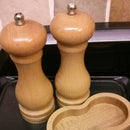Introduction: Software Sliced Desk Tidy
I recently relocated to San Francisco for a 2 month stint as an Artist-in-Residence at Instructables HQ. I carved out a work space in a corner by the entrance, nestled in test servers, ethernet switch-gear and Randy's ever spreading pile of electronics components. After securing a corner to work and a very nice HP Z600 desktop PC to play on this left me with one problem, MY clutter. An expanding sea of small hand tools, stationary and small project parts left me with just one single problem. I had no desk tidy...
With a mix of frustration at my decreasing work space from the spread of tools and envy at the success of colleagues with some of the 123D Make tools, I decided to throw together a quick pencil pot in my preferred CAD software, Alibre Design, and then slice and dice it with a preview version of Autodesk's 123D Make to make it ready to slot together after laser cutting.
Step 1: 3D Design
I started by drawing 40mm x 40mm squares on the XY plane, then extruding them up to different heights. I made one large 80mm x 80mm square at the front to hold paper clips and other small items.
Alibre has a nice tree structure to the way you put together a 3D model. You can skip back and forth between stages of design and add new bits. Once I'd drawn the solid, I used the Shell tool to hollow out each of the uprights to the thickness of the material I'm using. In this case, 1/8" smokey acrylic. In this manner, I could easily go back and adjust it for a different thickness of acrylic, cardboard or wood.
Included in this step are the original Alibre file and the STL that was exported for use with 123D Plate.
Step 2: Slicing
The STL exported from Alibre was opened in the 123D Make preview. The particular beta version I had access to has an algorithm in it which allows you to turn a shell of a box into slices with tabs and slots that will fit together. It automatically adds the finger joints, allowing you to choose quantity and thickness of material.
The image for this step shows a screenshot of the 123D Makescreen, showing the various parts that it has decided to cut the model apart into.
Included in this step is the EPS file generated by the algorithm for if you wish to laser cut your own. They are for 1/8" material thickness.
Step 3: Laser Cutting
Here you can see the laser cut acrylic pieces before the protective paper is removed.
Peel the paper off both sides of the acrylic then move on to the next step.
Step 4: Assembly: 1
The desk tidy will only assemble in one order, due to the way that 123D Plate cleverly takes the 3D model apart. Glue is not required, but will make it sturdier. Due to the construction of it, glue's only required towards the end of assembly and even then only a small amount is required.
Start by slotting the two small upright pieces into the center dividers.
Step 5: Assembly: 2
You can see the slot that 123D Plate has left in the two center parts. Put the bottom one into the base first.
Step 6: Assembly: 3
Then add the second one on top of it. These made a satisfying click when assembled, the tolerences were just right that it was a fairly snug fit.
The picture for this step shows the next parts lined up ready to go on.
Step 7: Assembly: 4
Pop the smaller outside pieces into place.
At this point a small amount of glue can be added to a few of the tabs at the corners and at a few points along the base. It's a fairly good fit already so this just protects against over loading the desk tidy with stationary.
Step 8: Assembly: 5
Finally, clip the two large outside parts into place, again with a sparing amount of acrylic glue in a couple of spots.

Participated in the
Make It Real Challenge

Participated in the
ShopBot Challenge

Participated in the
Furniture Challenge















